It’s been very interesting to see where C'Thun fits in with competitive decks. Warlock and Druid have been recently vying for the top spot, but one overlooked area could be Warrior. Ephemi explores this topic very thoroughly and comes to what I believe to be a pretty strong deck list! What follows is a very in-depth guide on how Ephemi arrived at the current list, how you can play common matchups, and how-to decide on mulligans.
Thanks to Ephemi for allowing us to re-host their guide!
I’m something of a Control Warrior aficionado, so I was excited to explore C’Thun Warrior which I played exclusively this season, going 83-45 (65%) from rank 14 to Legend. Upon review this has become a very long post, so if you’re curious about particular cards or matchups, Ctrl+F might be the way to go.
I found my best matchups to be against other Control Warriors, Zoo, and most Priest/Mage archetypes. I performed quite decently against Paladin, Midrange Shaman, Tempo Warrior, and Midrange Hunter, went even against Miracle Rogue, and fared quite poorly against Aggro Shaman, Aggro Warrior, and Ramp Druid. I think the Control C’Thun archetype is quite powerful and a lot of fun. The final decklist isn’t particularly innovative, and was in fact largely based on Novalicious’ List on HearthPwn. What I have to offer in terms of discussion are the various adjustments I have made in terms of card choices and deck style, as I experimented with a great variety of cards and subtypes as I climbed, as well as some insight into the matchups that I made these adjustments to address.
Edit 5/14/16: I fiddled around in the Legend ranks with a version of the deck that replaces both Shield Blocks with Bashes. I went 13-5 before peaking at Rank 56.. I lost the next two games, going back to Rank 116. I attribute my momentary success largely to the very favorable Zoo and Midrange Shaman match-ups. Midrange Hunter was a deck I started seeing more of, and gave me quite a lot of difficulty.
Card Choices
First Experiments with C’Thun Warrior, or “Why I think Beckoner, Ichor, and Brann suck.”
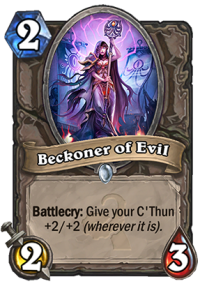
Initially, I was running a deck largely resembling Sjow’s early season list which notably includes Blood To Ichor, Slam, Brann Bronzebeard, and Beckoner of Evil, all of which I have excluded from my final list. I initially went 5-16 with this version, dropping from my rank 14 starting point to rank 15/16 (largely due to my initial ineptitude) before I decided to cut all three of those cards, 1 Acolyte of Pain, and Elise Starseeker for a much greedier package that included 2x Doomsayer, Harrison Jones, Skeram Cultist, Sylvanas Windrunner, Baron Geddon, and Ysera. This deck and subsequent revisions netted me a ~73% winrate (78-29) from rank 15 to legend.
I believe that overall, these changes made the deck strictly better even though it would appear that I sacrificed some ability to deal with early game aggression. The reasoning behind the cuts, and why I think cards like Brann Bronzebeard, Blood To Ichor, and Beckoner of Evil have no real place in a control oriented C'Thun deck, stems in part from a notion of “card efficiency”, and how it seemed to me to pose a threat to the viability of Control C’Thun archetypes. This consideration deals with the idea that in order to run C’Thun, you have to run a lot of bad cards with poor trading efficiency like Beckoner, Twilight Elder, and Crazed Worshipper, which often do little or nothing to contest other early minions. In place of Twilight Elder and Crazed Worshipper, people have simply opted to play more reliable and higher value C’Thun buffing cards like Disciple of C'Thun and C'Thun's Chosen. The other low value card, namely Beckoner, sees inclusion as a sort of Zombie Chow to hold the line against aggressive openings.
Cards like Beckoner of Evil and Ichor might appear to be decent anti-aggro tools, but the actual efficiency of these cards is so low and they’re so easily dealt with that you just end up with fewer cards in hand and fewer options approaching the midgame. River Crocolisk of Evil, having only 2 power, trades with essentially nothing in the current meta; it loses to Tunnel Trogg, Totem Golem, Feral Spirit, Mana Wyrm, Voidwalker, etc. It can potentially trade with some early Zoo or Hunter minions like Fiery Bat, King's Elekk, Flame Imp or Dark Peddler, but in those cases, the trade ends up being tempo or card inefficient. The only advantage to running the card is that it lets you possibly squeeze in the last C’Thun buff you need on turns 5-6 to reach the 10/10 buff threshold for activating Ancient Shieldbearer or Twin Emperor Vek'lor. At that point, and from that point on, you’re effectively playing a 2 mana spell that buffs C’Thun +2/+2 and does 2 damage to a character of your opponent’s choosing.
Blood To Ichor lets you activate Execute and Acolyte of Pain, and possibly push for 1 damage on killing a minion. The 2/2 that it leaves behind won’t trade too well without help from other cards, and without Battle Rage to capitalize on the potential for card draw, the tempo you gained from playing Ichor ultimately pales in comparison to the card advantage you lose. The very best case early game scenario for the card is that you cast it on a turn 1 Tunnel Trogg while going second, in which case it goes 1 for 1. Drawing either Beckoner or Ichor in the mid to late game feels awful, since they are just so underwhelming.
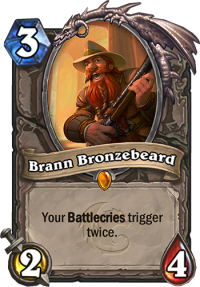
Brann Bronzebeard deserves a separate discussion since it doesn’t appear to be card inefficient at all, potentially allowing for some spectacular swing turns, like 20 armor from Ancient Shieldbearer or a third Twin Emperor, or even a drool inducing double C'Thun activation, right? The issue with playing Brann for those situations is that Brann becomes a dead card in hand for a majority of the game, part of a 10 mana 2 card combo, while the latter case with Brann+C’Thun is plainly unrealistic. Any combo that takes 2 turns to set up is hardly a combo at all, especially one that requires a 2/4 minion to stick on board. The phrase “Win More” seems to apply quite aptly here. One might counter, claiming that Brann is flexible, as he can also be used in combination with a C’Thun buffing card early on to instantly achieve the 10/10 threshold, or with Ravaging Ghoul/Disciple of C'Thun to get that double activation, or he might even just see play on turn 3 as a 2/4 to counter aggressive starts. In these scenarios, Brann’s card slot would be better filled by another C’Thun buffing minion that actually trades well, since those can actually be played without needing to have another card in hand, and playing a 3 mana 2/4 again hearkens back to our issue of card efficiency. It doesn’t trade with anything, doesn’t do anything the turn it’s played, and hoping it sticks a turn to allow for a double battle cry is both too optimistic and too delayed when you could be running an active card instead.
Doomsayer, Greed, and why Skeram Cultist ultimately didn’t make the cut.
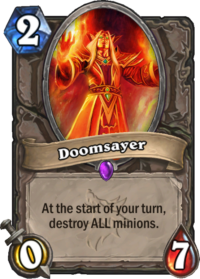
So why go full greed while relying on Doomsayer to shore up the early game? Doomsayer deserves special mention since this card alone has enabled the incredibly heavy curve that I ended up settling with during the climb from rank 15 to about rank 3. You’ve heard this before at this point, but Doomsayer is incredibly good now that cards like Ironbeak Owl, Mad Scientist, Haunted Creeper, and Nerubian Egg are out. It’s especially good at answering aggressive starts from Shaman, Zoo, and Mage, and it’s decent even against decks like Priest who often have difficulty pushing the extra damage to answer it without Shadow Word: Pain. It’s extraordinarily flexible, since you can play it out with other cards, forcing your opponent to choose between spending resources on removing the Doomsayer while leaving your other minions alive, or just ignoring the Doomsayer and sacrificing initiative the next turn. Played on an empty board, it essentially guarantees initiative before a big turn or a big C'Thun allowing all the shots to go face, or it can simply be used to stall board, though in these cases Stampeding Kodo should be a concern, which is seeing play in decks outside of Paladin now largely in reaction to Doomsayer inclusions. Perhaps the most important tidbit about Doomsayer is that it doubles the amount of good mulligan targets you have against faster decks, where before you could only really dig for Fiery War Axe. With both FWA and Doomsayer, the chances of hitting at least one of those cards in an aggressive mulligan gets to ~66% going first and ~74% going second, and drawing either essentially guarantees a few turns of safety. Cards like Slam, Bash, and Revenge which might also be run and mulliganed for just don’t stand up to Doomsayer in terms of both standalone and strategic value. Against Midrange Shaman and Zoo especially, being able to answer early drops with Doomsayer while forestalling critical board development can be game deciding. What’s a Tempo Mage going to do against an early Doomsayer, use precious burn that could be going face or at value targets instead? In many cases yes, but it hurts for sure. Against decks like Hunter who have clear power spikes on turns 4, 6, and 8, a well timed Doomsayer might give you just enough time to develop an answer against power cards like Savannah Highmane and Call of the Wild. Against N'Zoth, The Corruptor decks that run Sylvanas Windrunner, you can be cheeky and give them Doomsayer, clearing the board on their turn. Against Druid, Doomsayer is iffy since it lets them stall out and ramp big cards, but in that match-up, forcing out a Swipe or a Wrath on your 2-drop can also be valuable. Against Rogue or a more Midrange/Tempo Warrior, Doomsayer is easily answered with a mid-sized minion and a weapon. In those match ups, the best case scenario is that it eats removal like Eviscerate, Sap, or Execute.
So now onto the greed. Harrison Jones and Sylvanas Windrunner probably don’t need my justifying here. Harrison because the most popular classes at the moment are all weapon classes. Sylvanas because it’s incredibly frustrating to deal with, especially with reduced incentive to run silence. Baron Geddon to close the game decisively against Zoo and Midrange Totem Shaman. Ysera saw inclusion in the first revision that didn’t include Elise Starseeker or Doomcaller. I was committed at this stage to building a deck with a lot of strong, independent threats that could be played out consecutively to beat my opponents from turns 6-10, without allowing the game to extend beyond that.
Skeram Cultist was also in the list for this reason, since its raw stat line alone makes it a formidable threat that demands removal that can then no longer be used to on subsequent threats. It also conveniently buffs C’Thun the turn before all the 7 drops that need C’Thun at 10/10. This panned out exceedingly well against Priest, which just doesn’t have enough removal to answer an additional Shadow Word: Death target in the form of Skeram Cultist, and an additional Entomb target in the form of Ysera. I was also able to beat out other Control Warriors who were running Elise while I wasn’t, simply by having more threats than they could answer, and by saving C’Thun/Sylvanas for when they played Golden Monkey. Even marginally, against Paladin, having a string of early threats rather than having all my threats stacked on the end threw off a few games that would have gone differently. If for some reason Control Warrior and Control Priest become more prevalent, I would consider running 2x Skeram Cultist simply because outside of Druid, the 5-7 slot is so sparse in terms of bulky, stat-heavy minions, and big minion removal has gotten sparser now that Big Game Hunter has been cut from a lot of decks. The exceeding disadvantage to the card, and the main reason it was cut, is that it fares very poorly against Tempo oriented decks, which have usually established a fairly threatening board by turn 6.
Final Revisions, an Alternate List, and “I wish I had included Bash for this 11/3 SI-7 Agent.”
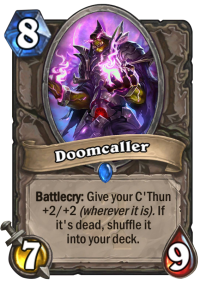
So now onto the next set of revisions: Ysera and Skeram Cultist out for Doomcaller and Elise Starseeker. I initially subbed Ysera as a replacement for Doomcaller because I didn’t feel that Doomcaller was a sufficient standalone threat, and it would in theory just rot in my hand until I played C’Thun. In practice, it has allowed me to play my C’Thun more aggressively and flexibly, so that the “dead card” is now Doomcaller rather than C’Thun itself, and for that matter Doomcaller can either be played as a threat on its own or to actually constitute 2 threats, its own big body and a second, even larger C’Thun. The only case in which Doomcaller is strictly worse than Ysera would probably be against Priest, since they usually just save Entomb for C’Thun and prevent it from being reshuffled into your deck. Against Shamans with Hex and Mages with Polymorph, it’s usually the case that getting value from a second C’Thun isn’t going to be the deciding factor of the game. Against control decks like Warrior and Paladin, the second C’Thun can be absolutely backbreaking, especially if the first already gained you a fairly significant advantage by clearing a couple of their minions or threatening their life total. The dream I had for the Ysera list of curving out turns 6-10 against control decks only really pans out when you’re reliably going against control decks, and even then having the exact cards you need on curve can be a little inconsistent at the best of times. As it turns out, getting crushed by tempo decks on turns 4-6 often forestalls your ability to win by playing threats from turn 6-10.
Elise Starseeker was originally a Bloodhoof Brave in an attempt to have an answer for Zoo, Tempo Warrior, and Aggro/Midrange Shaman on turn 4. It ended up not doing that great because I could never get the enrage effect off the turn I played it, and the 2 attack would never quite trade for an entire minion before they finished it off with removal like Rockbiter Weapon after a bump with Totem Golem, for example. I figured at that point if I was going to build my deck greedily and let Doomsayers and and FWA carry me against aggressive decks that I may as well try to win all of the control match ups or at the very least the mirror match up, so Elise found her way back into the deck and did quite a bit of work in that regard.
At Rank 1, I started encountering an abundance of Tempo Warrior and Miracle Rogue, so I swapped to a list I saw VLPS running that foregoes some threats and drops Doomsayers and Gorehowl in order to pick up Bash, Slam, Revenge, and an Acolyte of Pain, since as already mentioned, Doomsayer just doesn’t cut it when your opponent has an abundance of damage options from hand. Bash was probably the card that I missed the most from my list, especially given the prevalence of Tempo Warriors charging Kor'kron Elites into your face, Rogues with Cold Blooded SI:7 Agent giving your hero portrait the quick and dirty, and Shamans hiding 0/3 totems behind Feral Spirit. I saw the extra Acolyte and and Slam as being good compensation for the card draw you would also be lacking against these decks.

Cutting Gorehowl was actually a choice I liked quite a lot, since at this point in the meta most players are running anti-weapon tech and will save it for Gorehowl once they’ve ascertained you’re playing Control Warrior, so by not actually including it you get the leg up on them and they are essentially holding a dead card in anticipation for a nonexistent card. I honestly think VLPS’ version will be better than mine in for climbing in general, but I only played 5 games with it, going 4-1 before switching back to the list I posted originally for the final game to legend against a Tempo Warrior.
The remainder of the card choices in the list I think have rightfully earned “core” status, including 2x Ravaging Ghoul and 2x Brawl, cemented due to the prevalence of Zoo, Midrange Shaman, and N’Zoth decks. I did have to think about 2x Shield Block and 1x Acolyte of Pain versus some combination of Bash, Block, and Acolyte, and I think there’s a great deal of potential flexibility there. Running fewer Acolytes is fine since the average card value of the list is so high that you won’t really be hungry for draws later on in the game, though I would always include at least 1. The problem with Bash is that without more card draw, it’s a fairly low value or low tempo card that goes 1 for 1 while recouping some life total. Again, incredibly good against Kor’kron, good with FWA to hit Bloodhoof Brave, good against Flametongue Totem/Mana Tide Totem, and good to help remove Rogue Minions which you want to avoid tanking with your face. Good also against some Mage minons like Sorcerer's Apprentice, Cult Sorcerer, or Ethereal Conjurer, another match-up where you might value your life total more as well. Kind of bad when used in conjunction with another card to trade up since you’re going 2 for 1, and quite bad against most Zoo, Shaman, and Hunter minions.
Mulligans and General Strategy
I won’t be going waxing super verbose about all the specific match-up strategies. Instead I will mention some mulligan and general notes here, as well as notes for some of the weaker match-ups afterwards. The problem with writing up strategies for specific match-ups is that with the degree of variety present on ladder, there are too many archetypes to cover comprehensively. Every class has at least 2 archetypes associated with them, with Mage having at least 3 and Warrior having maybe 5-6 decent and fairly common ladder archetypes. Each individual archetype has a wide variety of potential power cards and turns which are best learned by actually playing with them or playing against them a lot.
For the most part, Fiery War Axe and Doomsayer are your big keepers and worth mulliganing for.
Disciple of C'Thun is a decent keep in most situations, but if I would toss it if it were the only card worth keeping that I was offered against a Zoo or Aggro Shaman against which you desperately need better options.
Slam and Bash aren’t actually included in my list, but if you choose to sub them in, Slam is always keepable and Bash I would keep against Warrior and Mage especially, and against Shaman and Hunter if you can’t find anything else.
Acolyte of Pain is really only a good keep against Paladin and perhaps Rogue now that some lists have elected to cut Deadly Poison. Acolyte is probably a fine keep against most other classes as well since it forces checks on certain early removal cards, and also since it’s one of your sparse early drops that additionally that helps with cycling into threats later on. The worry is that it doesn’t quite trade for another card and that you lose all your draw options outside of Harrison after that point. It’s particularly important to get multiple Acolyte draws in certain match-ups such as Reno Warlock in order to keep up. Drawing against Priest is also fine now that they can’t just remove your threats until Fatigue. I would only hesitate playing Acolyte to draw against another Control Warrior or C’Thun warrior, since you’ll already be cycling with Harrison in that match up, and the pace allows for turn by turn draws to keep you up. It might be worth it to cycle for more threats if your opponent is too liberal with removal and expends it all early.
Ravaging Ghoul is an excellent keep against Zoo and Paladin, an okay keep against Hunter. It’s also worth keeping if your starting hand is otherwise fairly bad.
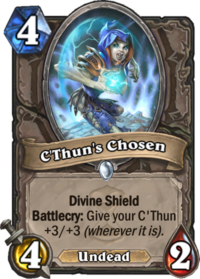
C'Thun's Chosen is a keeper against Priest and Control Warrior, and maybe against Hunter if you can’t find anything else. It’s less good against Rogue since they just need to hit it and then backstab, but Rogue usually doesn’t play minions until turn 3-4 so this card lines up quite nicely against that pace.
Elise Starseeker probably sits on the very fringe of what would appear be an acceptable keep. I personally would throw it away every time and hope for something better, since it doesn’t line up at 4 mana with any card you can reasonably expect your opponent to be playing. Trying to cycle into an early Golden Monkey also just isn’t a good strategy when your more controlling opponents can just slam N’Zoth or C’Thun.
Harrison Jones might be tempting to keep against most weapon classes, but I would only really hold it for N’Zoth Paladin or Control/Patron Warrior, and occasionally Rogue if there’s nothing else that I can really keep. There’s no real way of knowing if the Warrior you’re playing against is going to be Control though, so pitching it against a random Warrior player is probably advisable, since it’s far too slow against the faster Warrior variants.
Brawl if you’re sure you’re playing against Patron. There’s no way to be sure against a random ladder opponent. It might also be worth keeping against Tempo Warrior, Zoo, and Shaman if you have at least 1 other strong keep, though this mulligan strategy leaves you susceptible to a rush-down from Aggro Shaman/Warrior.
Justicar Trueheart is only a keep against Freeze/Reno Mage and Control Warrior. The former match-ups are already pretty free, so it’s likely best in those scenarios to mulligan as if you’re playing against Tempo/Yogg Mage. In the latter case, only about 1/3rd of Warriors are actually playing control, so hedge your bets and toss it unless you’re sure.
Execute is possibly a keep against Ramp Druids and Priest, but not really Shamans since not enough of them are running Flamewreathed Faceless to justify it, in my opinion. It might be worth keeping in the Shaman case if you find both Ravaging Ghoul as an activator and the Execute. I have seen 2 Warlocks running Mountain Giant in their Reno lists, but the vast majority were Zoo decks, against which Execute is mostly dead until they play Sea Giant or Doomguard later on.
Shield Block and Shield Slam are worth keeping together against Rogue, and maybe Druid, Priest, and Mage. The idea behind keeping hard removal in general is that you generally have a good idea with these classes when their big minions are coming out. For Rogue, it’s almost always on turn 4 with Tomb Pillager or Violet Teacher, against which Shield Block+Slam lines up really well, but for which FWA+Disciple is better in general. I’m not sure if it’s worth ever keeping Shield Block on its own, except maybe against Rogue.
In General there’s nothing particularly demanding about playing the deck compared to standard Control Warrior. I would actually argue that this deck is more straight forward than most others since you have fewer options at each mana slot than you would for other decks like Zoo or Shaman. The general game plan is to attempt to remove early on with FWA and Doomsayer, while buffing C’Thun to 10/10 from turns 3-6, before swinging the game with on later turns with Brawls and high value minions. This plan falls apart easily if you don’t draw your C’Thun buffing minions on time and your hand becomes clogged with inefficient C’Thun 7 drops, but the likelihood of hitting C’Thun 10 is good enough with 4 buffing minions that it’s rarely game losing unless no weapons or Doomsayers were drawn early on.
Decks I Struggled Against
The deck is built to have inevitability on its side, excepting perhaps the matchup against N’Zoth Paladin, where they have as many answers as you have threats and a very frightening late game with N'Zoth, The Corruptor. Being able to actively threaten a control Paladin deck instead of stalling until losing to N’Zoth was perhaps one of my primary motivations for choosing C’Thun over standard Control. N’Zoth Paladin goes well when you’re able to curve out well enough with your threats to run them out of efficient answers, or when you’re able to draw into effective answers for their minions without having to use both Brawls. Removing all their tokens makes Equality harder to use, and If they don’t run Justicar Trueheart or Harrison Jones for Gorehowl, their pressure is dramatically reduced since they can’t force you to play anything. The entire N’Zoth deck consists of removal, draw, big bombs, and healing, leading to rather clunky turns and a lot of reactive dead cards in hand. As mentioned in the post about Doomsayer, it can be held alongside Shield Slam until N’Zoth comes down to result in a relatively clean board if they played Sylvanas Windrunner earlier in the game.
The matchup against Miracle Rogue degenerates depending on whether they can conceal an Auctioneer early, at which points your options to interact with them become limited to coin flip Brawl. However, even match ups where the Rogue gets perfectly timed conceals and draws through much of their deck are winnable as long as you’re able to manage both your life total and their minion density by drawing multiple cards off Harrison Jones and Acolyte of Pain. Rogue is almost similar to Freeze Mage in that they have a finite amount of damage from hand, so as long as you can keep their minions in check and your life total outside of burst range, they eventually run out of gas going through the entire deck. The issue is that with enough cycle from Gadgetzan Auctioneer, they’ll be able to output more threats than can be answered reasonably and end up outpacing you.
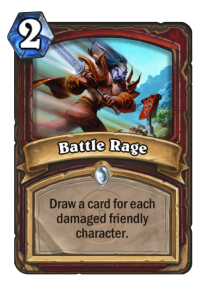
For much the same reason as with Miracle Rogue, Tempo Warrior with a good Battle Rage can at times just overwhelm you before you can respond adequately, though this match-up is less bad because they have a harder time answering the minions you play, and your removal in the form of Brawls and Execute/Shield Slam line up better against the way they present threats. Both archetypes are rather difficult to time Doomsayer against, but a Warrior without FWA or a strong board is a lot more vulnerable than a Rogue at any given point.
The only really bad match-ups for the deck that I have experienced have been Pirate Warrior and Aggro Shaman, which just win the game with mid sized minions and weapons into burn before you can adequately respond and stabilize. Including Bash and Revenge might go a long way for shoring up these match-ups.
I’m honestly uncertain whether Ramp Druid is actually a bad match-up, or if I just played it poorly. Doomsayer is certainly a lot less straightforward to use, and difficult to time against Wild Growth, Nourish, and Innervate. Fiery War Axe doesn’t answer Druid minions well, so the early game plan is essentially non-existent. At the same time, Druid doesn’t seem well equipped to answer your plays from turn 4 onward, while all you need to answer their cards are timely Execute or Shield Slam. It ends up coming down to whether the Druid player draws enough Ramp cards, which seems to put them in a favorable position.
Midrange Shaman deserves a special mention as the most prevalent deck on ladder during my climb. I think with the inclusion of Doomsayers, it’s not unreasonable to claim that we are actually favored. This was actually another match-up in which I missed Bash, mostly to remove Flametongue Totem. However, if you’re able to keep the board clear after a Doomsayer opening, the Shaman player will be on the back foot trying to recoup development all game, at which point a timely (and sometimes lucky) Brawl in response to a Thunder Bluff Valiant or Thing from Below will seal the deal. Shaman has a lot of powerful tools at each mana slot, but a good deal of later threats rely on having a board, and their card draw is ultimately lacking if you can answer Mana Tide Totem. Doomhammer + Rockbiter Weapon can pose a problem, but isn’t enough damage on its own without a board presence to finish you off.
There’s quite a lot I will leave intentionally unmentioned regarding individual match ups, since I don’t think I even have enough input really to say decisively how to play out different situations against different decks, due to the exceeding variation in card choices even within particular archetypes now. There is some reprieve in that respect though, since this deck assuredly has the late game advantage against pretty much every other deck. As such the strategy generally reflects a commitment to not losing rather than winning outright, saving key pieces to answer and deny your opponent’s win conditions rather than trying to pressure your opponent to death. For this, it’s important to keep in mind certain swing turns that your opponent can opt for, i.e. Thunder Bluff Valiant on Turn 7 or Archmage Antonidas + spells past turn 8.
Closing
I feel like there’s still much more room for refinement and I acknowledge that there’s a great deal that I may have gotten wrong in my analysis of the card choices. C’Thun warrior has some very clearly defined strengths especially in hitting those uniquely powerful swing turns with Ancient Shieldbearer, Twin Emperor Vek'lor, and C'Thun itself, and I think it’s at least as good as regular Control Warrior, though their relative strengths will certainly differ in different match-ups.
I hope also that other players who have been enjoying C’Thun Warrior as much as myself have additional input to offer, as this essentially concludes my input on what I feel to be a very refreshing take on Control Warrior. I encourage you to try the deck yourself and explore some of the nuances of a very exciting and diverse post WotOG meta.




















/rating_1_half.png)
/rating_2_off.png)
Can this achieve legend in the current meta? Any chance on knowing a win rate for this deck
C’Thun Warrior is still very strong, you might want to try this more updated deck list: http://www.hearthstonetopdecks.com/decks/sjows-season-26-standard-old-gods-cthun-control-warrior/
Thanks so much I was running an older C’thun deck and I was below a 50% win rate but I was facing a lot of midrange hunters
No problem, Hunter is a bad matchup unfortunately, so maybe the new list will help but that’s always going to be a tough one.
Can i Replace Baron Gaddon or does it get weaker if i do?
Revenge or Crazed Worshipper. The deck probably gets slightly weaker without Baron.
How about Grom for Geddon?
That could also work.
No malkorok really?
Doesn’t he belong to Tempo archetype along with Cairne and Varyan?
I don’t know where are you playing but on EU 15.05 this deck is literally unplayable.
I’m currently at rank 5 with this deck and since others made with it to legend in seasons 25/26 I hope I can too eventually
Great article. I’ll probably give it a try. I see Harrison Jones in many decks and I’ve been subbing Acid Swamp Ooze for him because I don’t have him. His he worth crafting? Or just stick with the weaker body, no card draw Ooze?
I crafted Harrison back when GvG came out and never regretted it since, now he’s seening even more play than before
Pretty in-depth guide, which I find hard to not adore.
I recently spent 2400 dust crafting Emperror Vek’lor and 2 crazed worshippers and struggled, maybe I’ll do better with this new approach
+Seconding Wombat question
He said that he cut gorehowl. But it is in his decklist. What did he cut it for
He was refering to VLPS list which doesn’t have the Gorehowl
https://gyazo.com/6cc33e287a4c3d861d6730c32c0ada9b
Sorry for bad English, hope you get my point
He didn’t cut it, if i got that sentence right. He is talking about VLPS list, which he played a bit. (list I saw VLPS running that foregoes some threats and drops Doomsayers and Gorehowl… ) He wrote couple arguments against gorehowl, but then he just said, that he returned back to his list. he didn’t draw a conclusion of this card.